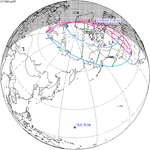Solar_eclipse_of_March_6,_1905
Solar eclipse of March 6, 1905
20th-century annular solar eclipse
An annular solar eclipse occurred on March 6, 1905.[1][2] A solar eclipse occurs when the Moon passes between Earth and the Sun, thereby totally or partly obscuring the image of the Sun for a viewer on Earth. An annular solar eclipse occurs when the Moon's apparent diameter is smaller than the Sun's, blocking most of the Sun's light and causing the Sun to look like an annulus (ring). An annular eclipse appears as a partial eclipse over a region of the Earth thousands of kilometres wide. Annularity was visible from Heard Island and McDonald Islands (now an Australian external territory), Australia, New Caledonia, and New Hebrides (now Vanuatu).



































